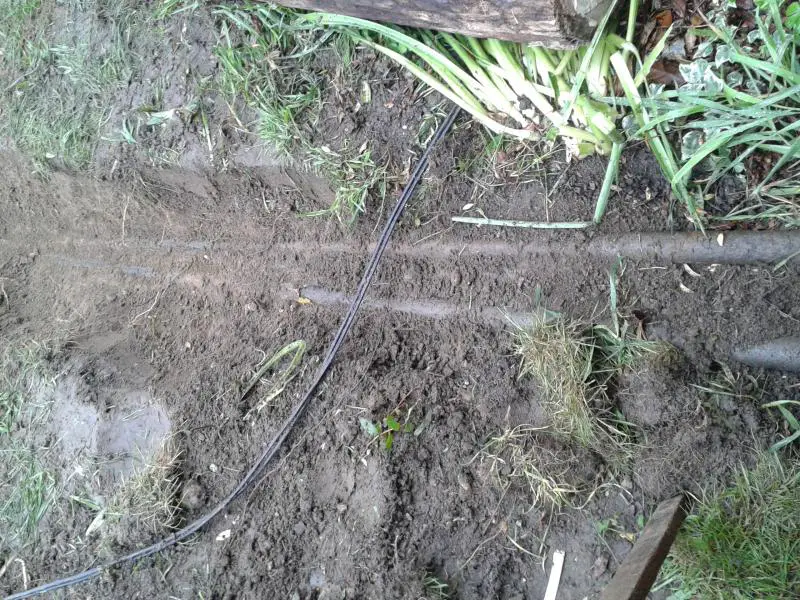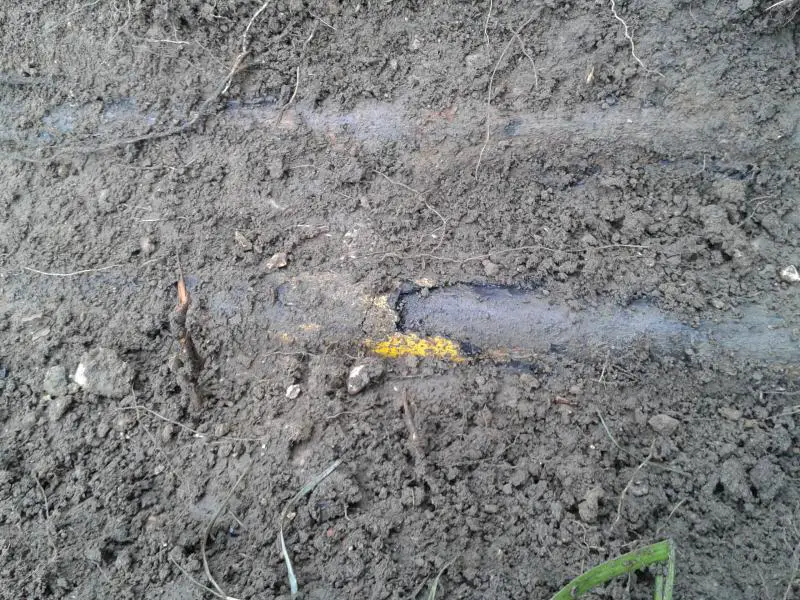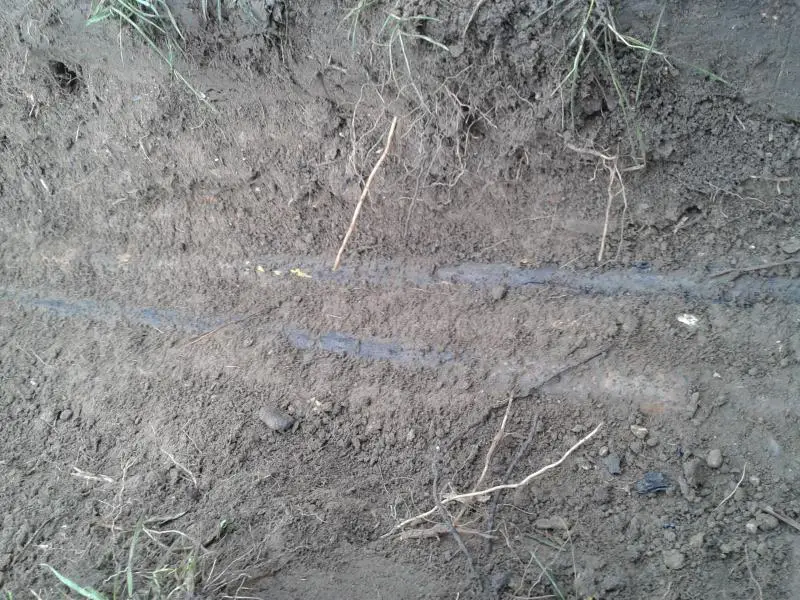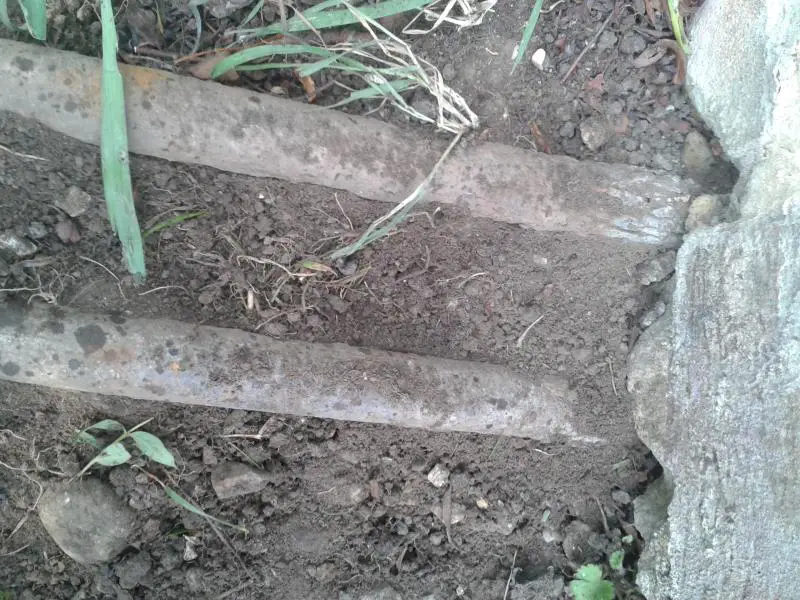You are using an out of date browser. It may not display this or other websites correctly.
You should upgrade or use an alternative browser.
You should upgrade or use an alternative browser.
Can anybody identify these 1.5" 'buried' pipes? Photo.
- Thread starter nv_london
- Start date
Sponsored Links
A broomstick or similar piece of wood will do. It's just something solid that will transmit mechanical vibrations (ie noise) so you don't have to put your head down the hole to get your ear against the pipe - which would have your neighbours rolling around in hysterics.
Sponsored Links
Water company guys use them all the time. They are called listening sticks.
Update: I've just been out there trying to dig a bit further to expose these pipes.
I'm starting to think they're gas pipes....from the photos you can see a bit of yellow on the outside of the pipes which crumbles away when I touch it (I think I remember reading somewhere that gas pipes are yellow colour coded?). Also, (if you squint a bit and know where to look) you can just about make out two connections along the length of these pipes as somebody previously mentioned. In addition, I can't hear any vibrations when I listen to these pipes.
Still not sure if they are 'live' as, even though they're in line with the gas meter, the inlet/feed to the gas meter comes in from a right angle a meter or so away?
Think I might start digging from the inlet to the gas pipe so see where that goes.
![]()
I'm starting to think they're gas pipes....from the photos you can see a bit of yellow on the outside of the pipes which crumbles away when I touch it (I think I remember reading somewhere that gas pipes are yellow colour coded?). Also, (if you squint a bit and know where to look) you can just about make out two connections along the length of these pipes as somebody previously mentioned. In addition, I can't hear any vibrations when I listen to these pipes.
Still not sure if they are 'live' as, even though they're in line with the gas meter, the inlet/feed to the gas meter comes in from a right angle a meter or so away?
Think I might start digging from the inlet to the gas pipe so see where that goes.
Well, I did ring National Grid last week when I found these pipes. They COULDN'T confirm if these were live or even if they were gas! They could only tell me where the closest underground gas mains/junction was but couldn't tell me how the service pipes were routed from there to my meter!
They also said that if I wanted the re-routed I would have to pay for that (including, digging up pavement/road etc etc).
HOWEVER, it was my understanding that if I damaged these pipes (and they were indeed live and gas) then they would repair them at their cost since they're not sufficiently buried to start with!
Now that I have more confidence that they are indeed gas pipes (yellow in colour with connections every so often), I'll ring them to see if they can send somebody out to 'bury' them a bit better as sooner or later they will be damaged - I'll also ask, if they will do this at their cost. (Hoever, I have a bad feeling that they'll only cover the cost of the pipes are damaged).
They also said that if I wanted the re-routed I would have to pay for that (including, digging up pavement/road etc etc).
HOWEVER, it was my understanding that if I damaged these pipes (and they were indeed live and gas) then they would repair them at their cost since they're not sufficiently buried to start with!
Now that I have more confidence that they are indeed gas pipes (yellow in colour with connections every so often), I'll ring them to see if they can send somebody out to 'bury' them a bit better as sooner or later they will be damaged - I'll also ask, if they will do this at their cost. (Hoever, I have a bad feeling that they'll only cover the cost of the pipes are damaged).
If it bugs you that much go to the local tool hire and get a CAT and genny. The genny will put a signal on the pipes and you will be able to trace the pipes with the CAT for as long as you want. Easy to use and not that expensive to hire.
Thanks for the CAT and genny idea. I'd never even heard of them before. I had a quick look at a hire shop and saw the complete set for around £70 - I may end up hiring it to get a better idea of where these pipes go. However, in the meantime....
Update: I've cleared a bit more soil away and uncovered this joint (see photo)....is it a compression joint i.e. can I just try to unscrew it to see if it's 'live'?
[GALLERY=media, 76588][/GALLERY]
Also, after digging a bit more around the inlet/feed to the gas meter it turns out that the pipe at this end which goes into the ground is actually yellow plastic.....could this yellow plastic pipe be spliced into one of the aforementioned metal pipes or would the yellow pipe be plastic all the way to the mains/junction?
Update: I've cleared a bit more soil away and uncovered this joint (see photo)....is it a compression joint i.e. can I just try to unscrew it to see if it's 'live'?
[GALLERY=media, 76588][/GALLERY]
Also, after digging a bit more around the inlet/feed to the gas meter it turns out that the pipe at this end which goes into the ground is actually yellow plastic.....could this yellow plastic pipe be spliced into one of the aforementioned metal pipes or would the yellow pipe be plastic all the way to the mains/junction?
Doesn't look like one to me - looks just like a coupler joining steel conduit (1.5", BTW, is a standard conduit size)is it a compression joint
You can try, but it looks too rusted for you to have any reasonable expectation of success, even if one of the lengths of pipe/conduit was free to turn i.e. not surrounded by soil anywhere, and not attached to anything at the other end. Which it is not.can I just try to unscrew it to see if it's 'live'?
But look on the bright side - if it is a live gas pipe then the second-to-last thing you want to be doing is undoing joints in it.
The pipe looks well rusted in your first photo, probably as a result of being in contact with mortar/render.
Link is threaded connection, perhaps conduit but more likely 1" or 1 1/4" BSP pipe. Undoing it will be possible with one end loose, but I'd be happier drilling it first, and even better just leaving it alone!
I do not believe yellow has been standard for gas for all that long. We have a water pipe in yellow rubber that was installed at house build in the 1950s. Having said that the depth of your pipe does not suggest it is water.
Link is threaded connection, perhaps conduit but more likely 1" or 1 1/4" BSP pipe. Undoing it will be possible with one end loose, but I'd be happier drilling it first, and even better just leaving it alone!
I do not believe yellow has been standard for gas for all that long. We have a water pipe in yellow rubber that was installed at house build in the 1950s. Having said that the depth of your pipe does not suggest it is water.
Can you tell what it is yet?
DIYnot Local
Staff member
If you need to find a tradesperson to get your job done, please try our local search below, or if you are doing it yourself you can find suppliers local to you.
Select the supplier or trade you require, enter your location to begin your search.
Please select a service and enter a location to continue...
Are you a trade or supplier? You can create your listing free at DIYnot Local
Sponsored Links





